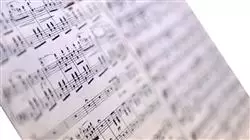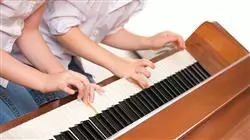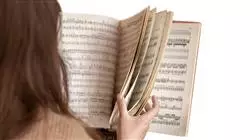University certificate
The world's largest faculty of humanities”
Introduction to the Program
Enter the exciting world of the piano with the guidance of experienced musicologists"

The piano has become a fascinating musical instrument that has been used throughout the history of music in a wide variety of genres and styles. Its importance in classical music is unquestionable, but it has also been elemental in the development of Jazz, Rock, Pop and many other genres. Since it is positioned as a key instrument in musical composition and music production, it is very interesting to get started in this world by the hand of versed experts.
This is the reason for the Postgraduate certificate in Introduction to Piano , designed to provide students with a solid foundation in piano technique and theory, and to help them develop their ability to play the instrument in the most effective way. During the program, students will examine how to read sheet music, play scales and arpeggios, or interpret different musical styles and genres.
But the best part is that this program is 100% online, which means that students can access the content at any time and from anywhere. The pedagogical methodology of Relearning, based on autonomous learning and the assimilation of concepts through repetition, also plays a decisive role. In fact, it is possible to organize the academic resources at the student's complete freedom.
You are late in enrolling if you want to master the four-hand technique on the piano"
This Postgraduate certificate in Introduction to Piano contains the most complete and up-to-date program on the market. The most important features include:
- The development of case studies presented by experts in Introduction to Piano
- The graphic, schematic, and practical contents with which they are created, provide practical information on the disciplines that are essential for professional practice
- Practical exercises where self-assessment can be used to improve learning
- Its special emphasis on innovative methodologies
- Theoretical lessons, questions to the expert, debate forums on controversial topics, and individual reflection assignments
- Content that is accessible from any fixed or portable device with an Internet connection
Perfect your coordination and internalization of the pedal with both hands to play the piano in an optimal way"
The program’s teaching staff includes professionals from the sector who contribute their work experience to this educational program, as well as renowned specialists from leading societies and prestigious universities.
Its multimedia content, developed with the latest educational technology, will provide the professionals with situated and contextual learning, i.e., a simulated environment that will provide an immersive education programmed to learn in real situations.
The design of this program focuses on Problem-Based Learning, by means of which the professionals must try to solve the different professional practice situations that are presented throughout the academic course. For this purpose, the students will be assisted by an innovative interactive video system created by renowned experts.
You will be a reference when it comes to improvising, mastering the main scales, chords and tonalities”

Lay the foundations to position yourself as a talented pianist after only 150 hours of academic study”
Syllabus
The need for high-level specialized preparation in the area of Music is what has led TECH to design and offer a Postgraduate certificate in Introduction to Piano . The syllabus focuses on the techniques and tools necessary for the analysis and mastery of the piano. Through the program, participants will have the opportunity to develop a complete knowledge of the theoretical and practical fundamentals of this instrument, always with the aim of interpreting and evaluating musical works with a critical approach. All this in only 150 hours of innovative and audiovisual content.

Specialize from anywhere and in only 150 hours with the most complete syllabus on Introduction to Piano "
Module 1. Introduction to Piano
1.1. The Piano
1.1.1. Organological Description of the Piano Musical Instrument
1.1.2. Main Parts of the Piano
1.1.3. Evolution of the Piano as a Musical Instrument
1.1.4. Most Relevant Composers
1.2. Musical Notes
1.2.1. Location of Notes
1.2.2. Treble Clef and Bass Clef
1.2.3. Association of Right Hand and Left Hand
1.2.4. Ascending and Descending Musical Notes
1.2.5. Fingerings
1.3. Figures, Dynamics and Musical Nuances
1.3.1. Musical Figures and their Practical Application
1.3.2. Dynamics and their Practical Application
1.3.3. Musical Nuances and their Practical Application
1.3.4. Figures, Dynamics and Musical Nuances Together on the Piano
1.4. Introduction to Musical Reading
1.4.1. Reading Sheet Music in Treble Clef
1.4.2. Reading Sheet Music in the Key of F
1.4.3. Union of the Two Musical Keys
1.4.4. Internalization of the Concepts Acquired at the Piano
1.5. Improvisation
1.5.1. Main Musical Scales
1.5.2. Main Musical Chords
1.5.3. Main Shades
1.5.4. Techniques of Musical Improvisation
1.6. Aural Application
1.6.1. Aural Recognition of Melodic Intervals
1.6.2. Aural Recognition of Major and Minor Chords
1.6.3. Aural Recognition of Augmented and Diminished Chords
1.6.4. Playing Intervals
1.6.5. Playing Major and Minor chords
1.7. Composition
1.7.1. Written Composition of a Short Musical Piece in Treble Clef
1.7.2. Written Composition of a Short Musical Piece in Bass Clef
1.7.3. Composition of a Passage of a Piece of Music Using Both Musical Keys
1.7.4. Improvised Composition of a Short Musical Piece
1.8. Sight Reading
1.8.1. Sight-reading Intonation
1.8.2. Rhythm at Sight
1.8.3. Sight Reading of a Short Piece of Music in the Treble Clef
1.8.4. Sight Reading of a Brief Musical Piece in Bass Clef
1.8.5. Sight Reading of a Passage in the Key of G and F
1.9. The Pedal
1.9.1. Introduction to the Pedal
1.9.2. Recognition of the Three Piano Pedals
1.9.3. Recognition of the Pedal Symbols
1.9.4. Coordination and Internalization of the Pedal with Both Hands
1.10. Four-hand Technique
1.10.1. What is Four-Handed playing?
1.10.2. Main Repertoire Composed to be Played with Four Hands
1.10.3. Performance of a Four-Hand Piece in its Melodic Part
1.10.4. Performance of a Four-Hand Piece in its Harmonics Part

Access with just a PC or Tablet to an extensive virtual library whose introductory piano resources will remain available 24 hours a day"
Postgraduate Certificate in Introduction to Piano
The piano is one of the most popular and versatile instruments in the world of music. Learning to play it can be a rewarding experience. Not only for the pleasure of playing music, but also for the cognitive and emotional benefits associated with its practice. In our University Course in Beginning Piano, students will learn the theoretical and practical fundamentals necessary to play the piano effectively and confidently.
This Postgraduate Certificate is designed for students with no previous piano playing experience. We will start from the very basics, such as correct posture, reading sheet music and identifying notes on the keyboard. As the course progresses, students will also learn more advanced skills. For example, hand technique, musical interpretation and improvisation. In addition, they will study the history of piano music, from its origins to the present day. The most popular and relevant musical styles in the contemporary context will be explored.







